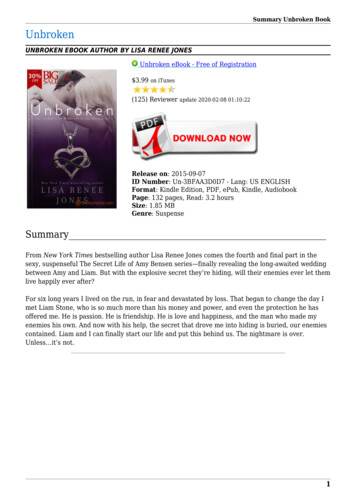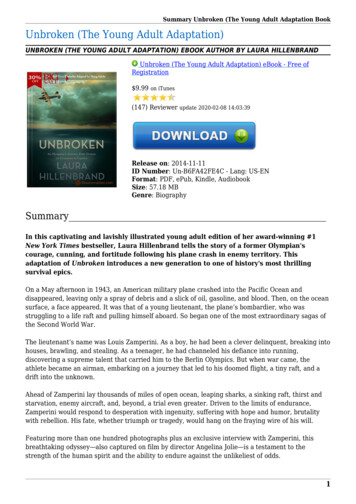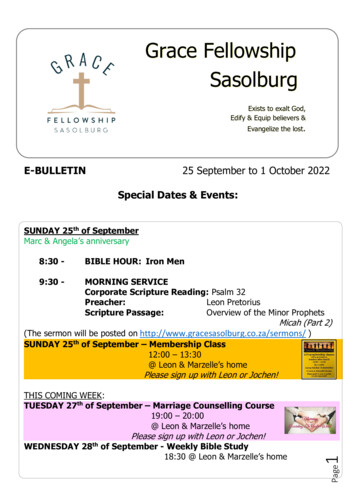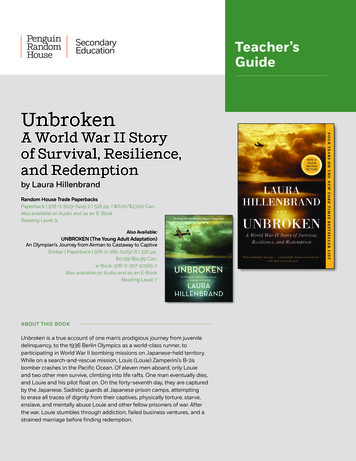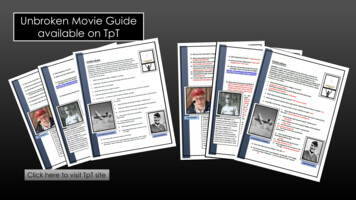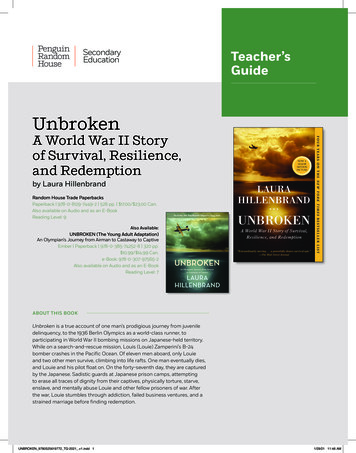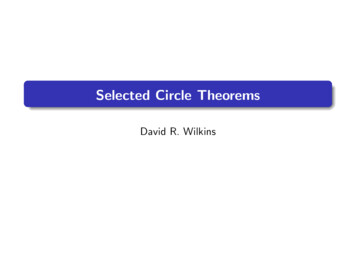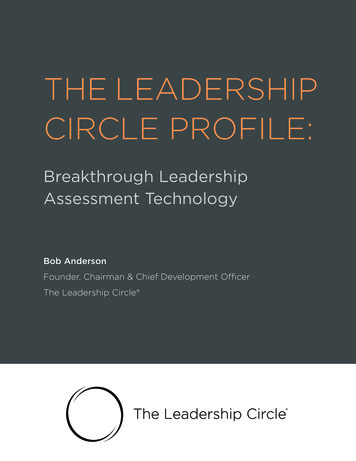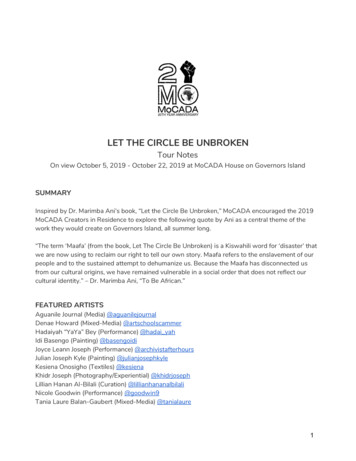
Transcription
LET THE CIRCLE BE UNBROKENTour NotesOn view October 5, 2019 - October 22, 2019 at MoCADA House on Governors IslandSUMMARYInspired by Dr. Marimba Ani’s book, “Let the Circle Be Unbroken,” MoCADA encouraged the 2019MoCADA Creators in Residence to explore the following quote by Ani as a central theme of thework they would create on Governors Island, all summer long.“The term ‘Maafa’ (from the book, Let The Circle Be Unbroken) is a Kiswahili word for ‘disaster’ thatwe are now using to reclaim our right to tell our own story. Maafa refers to the enslavement of ourpeople and to the sustained attempt to dehumanize us. Because the Maafa has disconnected usfrom our cultural origins, we have remained vulnerable in a social order that does not reflect ourcultural identity.” – Dr. Marimba Ani, “To Be African.”FEATURED ARTISTSAguanile Journal (Media) @aguanilejournalDenae Howard (Mixed-Media) @ artschoolscammerHadaiyah “YaYa” Bey (Performance) @ hadai yahIdi Basengo (Painting) @basengoidiJoyce Leann Joseph (Performance) @archivistafterhoursJulian Joseph Kyle (Painting) @ julianjosephkyleKesiena Onosigho (Textiles) @ kesienaKhidr Joseph (Photography/Experiential) @khidrjosephLillian Hanan Al-Bilali (Curation) @ lillianhananalbilaliNicole Goodwin (Performance) @goodwin9Tania Laure Balan-Gaubert (Mixed-Media) @tanialaure1
WHAT IS THE MEANING OF L ET THE CIRCLE BE UNBROKEN ?The title of the exhibition, Let the Circle Be Unbroken, isderived from the book of the same title by author MarimbaAni. The book served as inspiration for MoCADA’s 2019Creators in Residence. The creators were asked to interpretthis quote artistically through their chosen medium such aspainting, performance, and installation. The phrase refers togenerational trauma, legacy, and methods of liberation. The“circle” can be thought of as the cycle that many people ofAfrican descent experience such as cycles of injustice, cyclesof hardship, and the cycles of subsequent trauma derived fromthese elements.KEY TERMSMAAFA : a term which describes the historical and currentatrocities that the African people are being subjected to bynon-African individuals or political forces. It is derived from theSwahili word “great disaster.”1PAN-AFRIKANISM : a movement based on the idea that all people indigenous to Africa should unifypolitically, geographically, and sociallyLIBERATION : to be set free, either physically and/or mentally, from oppression or slaveryRECONTEXTUALIZATION : to change the context, or the circumstance in which a concept is oftenunderstood, of somethingAPPROPRIATION : to take something from someone else, often without permissionETHOS : beliefs that characterize a group of people or ideologyWORLD VIEW : the way in which people make sense of their surroundings, life, and the universeCOSMOS : the universe or a way of thinkingAFRICANIZATION : the modification of spaces or names to honor African culture and identity1 Harp, O.J. Across Time: Mystery of the Great Sphinx . 2007, p. 247.2
QUESTIONS1. What topics do the artists in this exhibition explore?2. In which ways do these artists recontextualize imagery we often view as “violent”? Thinkabout Julian Joseph Kyle’s large-scale family portrait paintings, one of which depicts thelynching of his great-grandfather (see image on page 2, left). Another example is KhidrJoseph’s self portraits featuring blackfaceand KKK costumes (see image, right). Howdoes the use of “uncomfortable” imageryforce the audience to think?3. How is “maafa” still being carried out today,both systematically and socially? Nameexamples.4. What are productive ways to liberateoneself from maafa?5. Why is art a helpful tool in dismantling oppressive forces? How can one ensure that theirart does this successfully?3
EXHIBITION THEMES1. THE MAAT/MAAFA/SANKOFA PARADIGMAuthor Marimba Ani developed the Maat/Maafa/Sankofa Paradigm concept to explain theconstruction, reconstruction, and destruction of Afrikan civilization. She uses this concept as ananalytical tool to explore the ways in which white supremacy functions to keep people of Africandescent at a disadvantage. Let’s breakdown each term:Maat Kamitic word for truth, justice, balance, and cosmic order. Although “Maat” isconsidered a concept, the concept is also represented by a goddess of the same name.Maafa a term which describes the historical and current atrocities that the African people arebeing subjected to by non-African individuals or political forces. It is derived from the Swahiliword “great disaster.”2Sankofa a word from the Akan tribe of Ghana. It is derived from three separate words - San,Ko, and Fa. Sa means return. Ko means go. Fa means look, seek, take.3 Together, the phrasetranslates to “ it is not taboo to fetch what is at risk of being left behind,” or “go back and get it.”Although these terms have significant meanings on their own, together, they explain a process maat can represent the seeking of truth, maafa can explain the current ways in which BlackAmericans are situated, and Sankofa can explain how Black people can get what’s rightfully theirsboth emotionally and tangibly.2. LET THE CIRCLE BE UNBROKEN BY MARIMBA ANISummary of the Book by SectionSection 1: Problems, Issues, TermsIn the first section of the book, Ani explains that many Black people in America have been toldthat they are “not African” because of the lost connections to their culture influenced by slavery.When African slaves were brought here, White Americans constantly attempted to subdueAfrican traditions such as drumming, singing, dancing, cooking traditional food, and more. Theoppressor often points out the loss of language, clothing, and language that occurred onceAfricans were unjustly brought here on slave ships. However, Ani argues that “ Africa survives inour spiritual makeup ”4 She emphasizes the concept of the spirit and how the African-American2 Harp, O.J. Across Time: Mystery of the Great Sphinx. 2007, p. 247.“The Power of Sankofa: Know History.” Carter G. Woodson Center , Berea College, , Marimba. Let the Circle Be Unbroken: the Implications of African Spirituality in the Diaspora . NkonimfoPublications, 2004, P. 1.34
ethos is inherently spiritual because of our unique traditions and beliefs. Ethos relates to theAfrican-American world-view and creates a sense of culture. Ani then asks a crucial question:“ what happens when a people are forced to live (survive) within a culture based on aworld-view that is oppressive to their ethos? ”5 This question sets the basis for the rest of thebook.Section 2: Utaratibu Wa Kutizama* African Philosophy and World-View*Utaratibu Wa Kutizama “ the way of the world” in Kiswahili6Ani describes the African c osmos as spiritual, whereas Western civilizations do not relate to thecosmos. She explains that development wisdom and knowledge depends on spirituality, while inWestern civilizations spirituality is often seen as irrational or seperate from tangible knowledge.According to Ani, African ideology relies on the existence of complementary pairs, while Europeanideology relies on the existence of opposing pairs.European viewOpposing pairs“Knowledge vs. opinion”“Objective vs. subjective”“Science vs. religion”“Mind vs. body”“Male vs. female”White vs. Black”7African viewComplementary pairs“Death and rebirth”“Heaven and Earth”“Spirituality and reality”Ani states, “The Diasporic Africa, in his or her being, represents the embodiment of theconfrontation of two divergent world-views: a spiritual ethos inheriting a sacred, cosmicworld-view forced to adjust to a materialistic society in inhuman circumstance.”8 This means thatpeople of African descent must mediate their two realities: one being of African origin and theother being of European influence.Section 3: Maafa* The Holocaust (Dehumanizing Circumstance, Human Response)*Maafa disaster in KiswahiliThis section details the capture and enslavement of African people and how this led to trauma.The oppressor’s goal was to destroy the self perception of African people, to make them feel5Ibid, P. 4.Ibid, P. 4.7Ani, Marimba. Let the Circle Be Unbroken: the Implications of African Spirituality in the Diaspora. NkonimfoPublications, 2004. P. 7.8Ibid, 11.65
worthless. However, out of this chaos rose a defiant response through song, dance, andmaintaining a Black identity.Section 4: Kuzinduka*: African Retentions in the Caribbean and South America*Kuzinduka r eawakening in KiswahiliAni explains the difference between Africans living in the Caribbean and South America vs.Africans living in the United States. The geographical elements of Caribbean and South Americancountries are more similar to African terrain than that of the U.S. Also, Africans in the Caribbeanand South America were allowed to play drums and were surrounded by more fellow Africansthan whites. Because of this, these groups of Diasporic Africans were able to retain their cultureas well as create new traditions with more ease than Africans enslaved in America. One examplebeing the creation of Vodou in Haiti, which was a response to France’s attempt to force Africansinto practicing Catholicism.Section 5: Kungana/Emi Lilo*: African Diasporic Ritual Drama*Kungana/Emi Lilo “to come together” in Kiswahili/”spirit possession” in YorubaAfrican world-view is expressed through rituals. Rituals such as dancing, singing, moving. Anistates, “We transformed suffering into an opportunity to express spirit.”9 She uses the term ritualdrama to describe the ways in which African-Americans used performance to enhance communallife.Section 6: “Kucheza Ngoma*: Communing, Shoutin’, and Feeling Rhythm”*Kucheza Ngoma “to dance to the drum” in KiswahiliAni emphasizes music as a crucial element of “spiritual expression”10 and the cosmos. Shedescribes the ability to turn trauma into celebratory survival as the “soul-force” of Black people. Incontrast to the emphasis on rationality in European culture, African culture values emotion as aform of artistic expression. It is important to express art outside of the white gaze.Section 7: “Nyama* Nommo: Signs of the African Spirit”*Nyama “energy of action” in Bamana119Ani, Let the Circle Be Unbroken, 25.Ibid, 33.11Ibid, 40.106
This section deals with the ways in which verbal expression is crucial to maintaining Africanspirituality and the expression of our ethos. These traditions live on through modern acts such asrapping, call and response, and the creation of our own language, or “slang.”Section 8: “ Amelogwa*: Denials of African-Diasporic Humanism”*Amelogwa “under the spell of witchcraft” in KiswahiliAfrican rituals function to restore order. Colonialism worked to disrupt these rituals and thereforecreate chaos. Because of colonialism, many African-Americans turned, and still to turn, againstone another. Ani describes the act of a Black person killing another Black person not as ahomicide, but as “suicide.”12Section 8: Tumalize Duara*: Three Hundred and Sixty Degrees*Tumalize Duara “let us complete the circle” in KiswahiliIn this final section, Ani focuses on highlighting the resilience of African culture. She states thatthe principles of the African-Diaspora do not operate the idea of “art for art’s sake” but instead“ art for life’s sake. ”13ADDITIONAL RESOURCES & INSPIRATIONSBOOKS Toward the African Revolution by Franz FanonToward the African Revolution by Franz Fanon is a five section text detailing the atrocities ofcolonization as well as his suggestions for how Africans can resist colonization forces. Hediscusses various topics such as the ways that doctors attempt to invalidate African people’scomplaints of pain and sickness, systematic racism, issues in his native country of Algeria, andhow to attain unity and liberation. This book influences many of the topics covered in thisexhibition specifically the ways in which we can overcome the effects of colonization. Simply theact of making art is an act of defiance against European influences. How We Fight White Supremacy by Akiba Solomon and Kenrya RankinHow We Fight White Supremacy features words of advice from artists, scholars, comedians,activists, filmmakers, and more on how to dismantle White supremacy. The book shows thatthere are many ways to dismantle this power structure such as education, community building,1213Ibid, 49.Ibid, 51.7
internal emotional healing, supporting black businesses, and more. Another important aspect ofrejecting white supremacy is creating art work. For example, some of the artists in the Let TheCircle Be Unbroken e xhibition dismantle white supremacy through depicting the historicaltreatment of Black people in their own way. Others go for a more experimental, abstract routethrough mixed media works and performance. The exhibition shows how various Black artistsuse different mediums as a form of healing from white supremacy. Yurugu by Marimba AniYurugu , written by the same author as Let the Circle Be Unbroken , discusses the innerworkings of white supremacy on a global level. It highlights the methods behind Euro-centricthought and outcomes of these methods. Ani critiques white supremacy from an African pointof view highlighting the violence and entitlement that historically exists in the Europeanmindset.Questions? Comments? Concerns?Contact us at: http://mocada.org/contact-us/80 Hanson Place Brooklyn, NY 11217phone: 612 834 5245http://.MoCADA.orgFollow Us IG: @MoCADA MuseumTW: @MoCADAFB: MoCADA MuseumWorks CitedAni, Marimba. Let the Circle Be Unbroken: the Implications of African Spirituality in theDiaspora . Nkonimfo Publications, 2004.Harp, O.J. A cross Time: Mystery of the Great Sphinx . 2007, p. 247.“The Power of Sankofa: Know History.” Carter G. Woodson Center , Berea College, 2018,www.berea.edu/cgwc/the-power-of-sankofa/ .8
LET THE CIRCLE BE UNBROKEN Tour Notes On view October 5, 2019 - October 22, 2019 at MoCADA House on Governors Island SUMMARY Inspired by Dr. Marimba Ani's book, "Let the Circle Be Unbroken," MoCADA encouraged the 2019 MoCADA Creators in Residence to explore the following quote by Ani as a central theme of the


